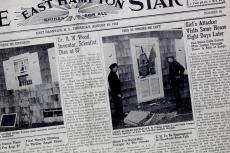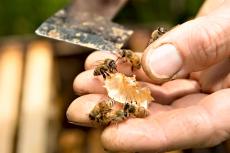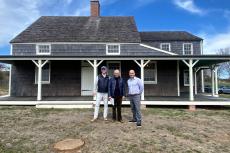This logbook tracks the voyage of the Daniel Webster, which set out from Sag Harbor for the Pacific in 1833 seeking whales, and returned the next year. The ship’s captain, Philetus Pierson (1801-1879), came from Southampton. He was a direct descendant of two members of Southampton’s earliest European families, Henry Pierson (1615-1681) and Mary Cooper Pierson (1621-1687).
As captain of the Daniel Webster, it was Pierson’s responsibility to keep careful records of each day, including bearings, weather, notable events, and of course whale sightings and captures. This record splits the journey, with the first month of travel in 1833 recorded in the first part of the logbook, before it cuts off and picks up again later in December of that year. Captain Pierson’s writing pauses as one Capt. Stratton Harlow takes over the Daniel Webster for a journey, before Captain Pierson’s return.
On one page, he describes three days near the east coast of Japan. On the first day, the ship sights and chases a whale but fails to capture it. On each of the two following days, the captain writes of chasing, striking, and bringing in a whale, ending each daily log with “nothing more worth of remark.”
What is most interesting about these entries is the illustrated sperm whales. The first is only an outline, the second and third are filled in and black. With these drawings in the log’s margins, a reader could flip through the log quickly and easily spot the days on which a whale was sighted or caught.
Captain Pierson led several whaling voyages from 1830 to 1839 on the Daniel Webster, the Stonington, and the Columbia. This log and logs from his other voyages can be transcribed from home through the East Hampton Library’s website with FromThePage, a crowdsourcing platform for archives and libraries by which volunteers transcribe, index, and describe historical documents.
Moriah Moore is a librarian and archivist in the East Hampton Library’s Long Island Collection.




